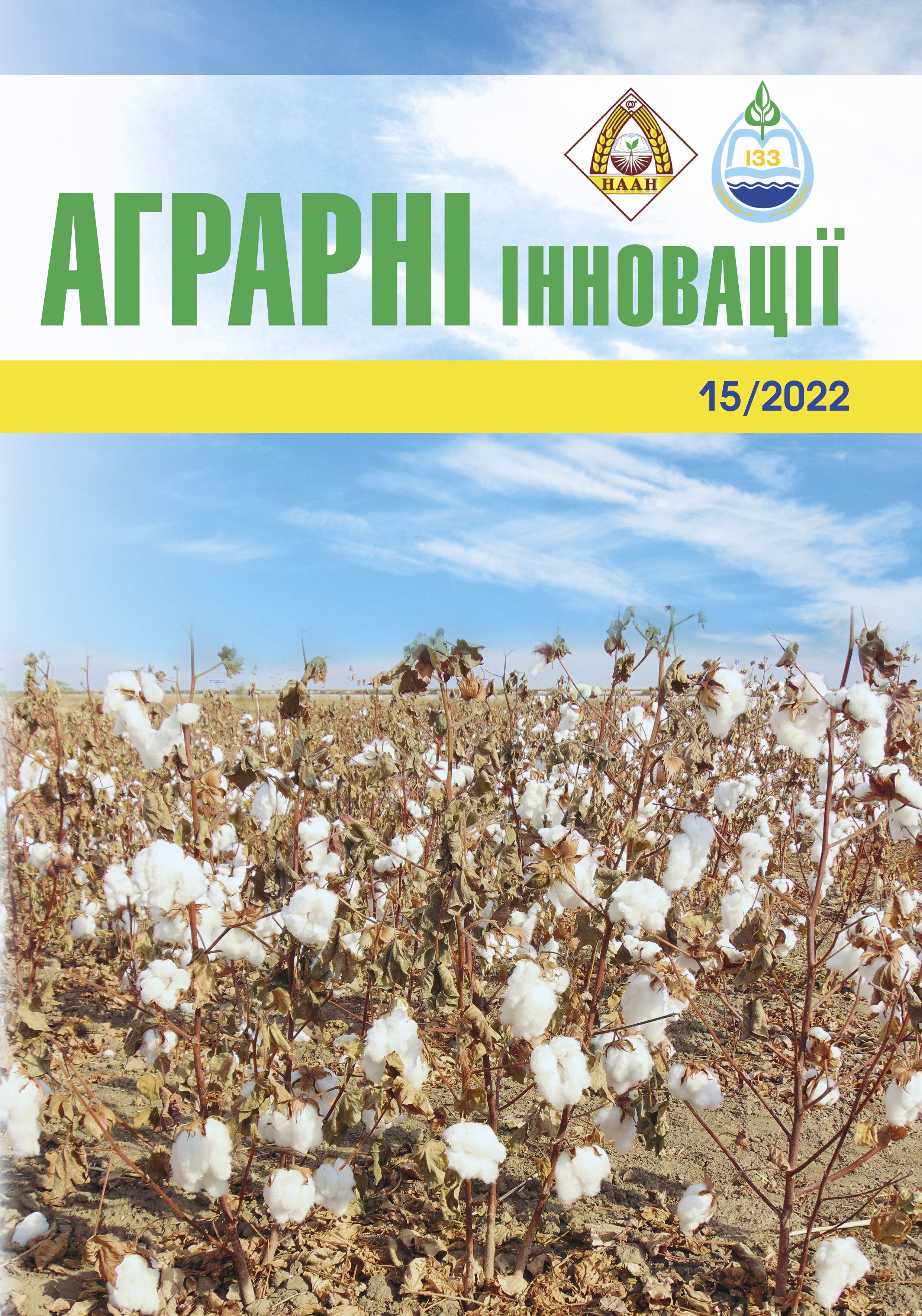The effect of the symbiosis of fungi and bacteria with the sunflower (Helianthus annuus) root system
Abstract
Purpose. To establish the effect of the symbiosis of mycorrhizal fungi and nitrogen-fixing bacteria with the root system of annual sunflower on plant growth, development, and crop productivity. Methods. Field, laboratory, and statistical methods were used in the study. Results. Mycorrhiza-forming fungi and nitrogen-fixing bacteria positively affected the growth and development of sunflower plants and the seed yield formation. In particular, the leaf area in the treatments with Glomus VS and Trichoderma harzianum Rifai. fungi (bio preparation Mycofriend), Tuber melanosporum Vittad. (biopreparation Mycovital), and bacteria Bacillus subtilis Cohn. (biopreparation Florobacillin) was 9.7–106.4% higher compared to the control on the 30th, 60th, and 90th days of cultivation. The leaf weight and root weight exceeded the control values by 6.6–138.8%, respectively. In addition, these treatments increased the soil moisture-holding capacity by 8.9–33.3% and decreased the share of soil lumps <0.25 mm by 2.2–9.7%. The yield of sunflower seeds in the treatments with these living organisms was 0.25–0.58 t/ha higher compared to the control. Noticeably also that seed treatment with Glomus VS and Trichoderma harzianum Rifai. (bio preparation Mycofriend) is more efficient in terms of impact on crop plant growth, development, and productivity compared to the others. In particular, in the treatments with Mycofriend, the increase in leaf area exceeded the control by 7.2–100.2%, while in the treatments with the other biopreparations (Mycovital and Florobacillin), the increase was 2.9–70.5% and 4.3–29.7%, respectively. In the same way, we observed the difference between other indicators, such as leaf weight, root weight, plant height, photosynthetic potential, photosynthesis productivity, etc., obtained in the treatments with Mycovital and Florobacillin. Conclusions. Application of mycorrhizal fungi Glomus VS, Tuber melanosporum Vittad. and Trichoderma harzianum Rifai. (biopreparations Mycofriend and Mycovital) together with nitrogen-fixing bacteria Bacillus subtilis Cohn. (biopreparation Florobacillin) for pre-sowing seed treatment improves the growth and development of sunflower plants and increases their productivity.
References
2. Маменко Т. П., Ярошенко Е. А., Якимчук Р. А. Водный статус и продуктивность озимой пшеницы при действии засухи и салициловой кислоты. Физиология и биохимия культурных растений. 2009. Т. 41, № 5. С. 447–453.
3. Bauma C., El-Tohamy W., Gruda N. Increasing the productivity and product quality of vegetable crops using arbuscular mycorrhizal fungi: a review. Science Horticulturae. 2015. Vol. 187. P. 131–141. doi: 10.1016/j.scienta.2015.03.002
4. The role of mycorrhizae and plant growth promoting rhizobacteria (PGPR) in improving crop productivity under stressful environments / Nadeem S. M. et al. Biotechnology Advances. 2014. Vol. 32, Iss. 2. P. 429–448. doi: 10.1016/j.biotechadv.2013.12.005
5. Мікробні препарати у землеробстві. Теорія і практика : монографія / Волкогон В. В. та ін. ; за ред. В. В. Волкогона. Київ : Аграрна наука, 2006. 312 с.
6. Smith S. E. Mycorrhizal symbiosis. 3nd ed. London : Academic Press, 2008. 815 p. doi: 10.1016/B978-0-12-370526-6.X5001-6
7. Ковалевський С. Б., Кривохатько Г. А. Посухостійкість та водоутримувальна здатність рослин Thuja occidentalis L. та її культиварів. Науковий вісник НЛТУ України. 2018. Т. 28, № 2. С. 77–80. doi: 10.15421/40280214
8. Розумова С. Г. Екологія рослин з основами ботаніки та фізіології : Конспект лекцій. Одеса, 2013. С. 119.
9. Скляр В. Г., Злобін Ю. А. Екологічна фізіологія рослин : підручник / за заг. ред. Ю. А. Злобіна. Суми : Університетська книга, 2015. 271 с.
10. Камінський В. Ф., Гангур В. В. Динаміка продуктивності вологи в ґрунті за вирощування пшениці озимої в сівозмінах Лівобережного Лісостепу України. Вісник Полтавської державної аграрної академії. 2018. № 3. С. 11–14. doi: 10.31210/visnyk2018.03.01
11. Присяжнюк О. І., Коровко І. І. Динаміка вмісту хлорофілів у листках цукрових буряків. Новітні агротехнології. 2015. № 1. doi: 10.21498/na.1(3).2015.118908
12. Колесніченко О. В. Анатомо-морфологічна будова листків Castanea sativa Mill. як фактор стабілізації водного режиму рослин в умовах посухи. Наукові доповіді Національного університету біоресурсів і природокористування України. 2015. № 5. URL: https://nd.nubip.edu.ua/2015_5/31.pdf
13. Поляков О. І. Агротехнічні і біокліматичні особливості формування урожайності і якості насіння соняшнику, сої, льону, кунжуту, рижію, молочаю в Південному Степу України : автореф. дис. … д-ра с.-г. наук : 06.01.09 / Ін-т сіл. госп-ва степ. зони НААН України. Дніпропетровськ, 2011. 38 с.
14. Доспехов Б. А. Методика полевого опыта (с основами статистической обработки результатов исследований). 5-е изд., доп. и перераб. Москва : Агропромиздат, 1985. 351 с.
15. Комп’ютерні методи в сільському господарстві та біології : навч. посіб. / Царенко О. М. и др. Суми : Університетська книга, 2000. 203 с.
16. Ничипорович А. А., Куперман Ф. М. Фотосинтез и вопросы повышения урожайности растений. Вестник с.-х. науки. 1966. № 2. С. 1–12.
17. Petiole – Petiole Leaf Area Meter (Версия 2.0.1) : Мобильное прикладное программное обеспечение. URL: https://play.google.com/store/apps/details?id=com.petioleapp.petiole
18. Polunina O. V., Maiboroda V. P., Seleznov A. Y. Evaluation methods of estimation of young apple trees leaf area. Вісник Уманського національного університету садівництва. 2018. № 2. С. 80–83. doi: 10.31395/2310-0478-2018-21-80-82
19. Вплив світлового режиму на ростові параметри та пігментний склад культивованих in vitro рослин Gentiana lutea / Грицак Л. Р. та ін. Regulatory Mechanisms in Biosystems. 2018. T. 9, № 2. С. 258–266. doi: 10.15421/021838
20. Kough J. L., Molina R., Linderman R. G. Mycorrhizal responsiveness of Thuja, Calocedrus, Sequoia, and Sequoiadendron species of western North America. Canadian Journal Forest Research. 1985. Vol. 15, Iss. 6. P. 1049–1054. doi: 10.1139/x85-170
21. Newman E. I., Reddell P. The distribution of mycorrhizas among families of vascular plants. New Phytologist. 1987. Vol. 106, Iss. 4. P. 745–751. doi: 10.1111/j.1469-8137.1987.tb00175.x
22. Wolff J. O. An evolutionary and behavioral perspective on dispersal and colonization of mammals in fragmented landscapes. Mammal Community Dynamics: Management and Conservation in the Coniferous Forests of Western North America / C. Zabel, R. Anthony (Eds.). Cambridge : Cambridge University Press. P. 614–630. doi: 10.1017/CBO9780511615757.019
23. Віннічук M. Мікоризація соняшнику арбускулярним мікоризним грибом Funneliformis mosseae та її вплив на перехід радіоцезію із ґрунту в рослину. Вісник Львівського університету. Серія біологічна. 2016. Вип. 72. С. 110–119.






